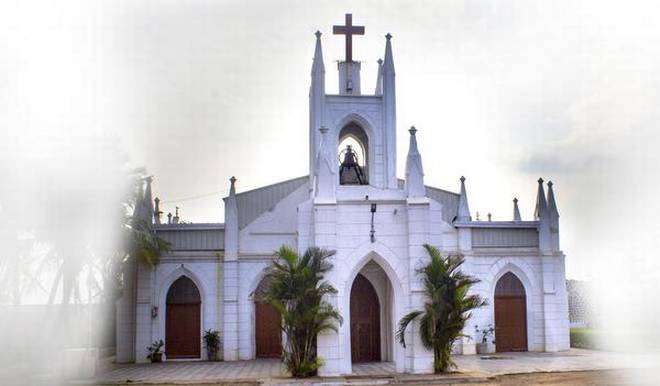St Thomas English Church that turned 175, stands a solemn witness to the passage of time
It’s late afternoon and birds keel over the squat steeple of St Thomas English Church (STEC) that stands at a bend on Santhome High Road. Children rush out of the school gate, a few swing from the low branches of trees that swish noisily in the brisk sea breeze. A winter coastal light washes over STEC’s white structure, complete with arches and turrets. Beyond stands a fishing hamlet barnacled to its compound wall that has replaced the fence with a wicket gate that opened to the beach and the bay beyond. Here, in the sweep of golden sands where Thomas, the saint who lends his name to the church and one of Christ’s 12 apostles walked, there is a mercurial stillness that hangs in the air — a quietude that has conquered the call of birds, chatter of children and the roar of waves for 175 years now.
I’m led on a guided tour of the 14-ground campus by Rev Richard Ambrose Jebakumar, the present presbyter, and Sheeba and Roshan, who were born and raised in this pastorate and whose families have been members for generations. High above the arched doorway is a crest emblazoned into the wall that spells out 1842 – the year the church was founded — and reads ‘Quarto septennial – abounding in grace, faith and love.’
“These are words that have largely inspired the philosophy of this church and its members,” says Rev Jebakumar. “Raised to meet the spiritual needs of the large number of Europeans who had made Santhome home, the church owes its existence largely to the dynamic Methodist missionary Robert Carver.” Carver, who is buried under the main altar of the church, arrived in India in 1824 and was a pioneer in the work of the oldest mission of the Church of England in India that worked at promoting Christian knowledge. By 1836, Bishop Daniel Corrie obtained a grant to build the church. By 1842, Carver had moved back to Madras from Mannargudi, and STEC was consecrated later that year. After Carver died a few years later, the church had many notable presbyters leading it, including AR Symonds and A Westcott, with the first Indian presbyters taking over in the 1930s. Their names now fill the wooden plaques that hang in a quiet corner of the church, although their work has for long defined the character of this pastorate. “St Thomas’ strength lies in the fact that it is a family church. Governor Thomas Munro worshipped here, and generations of families have been members here. It has helped foster a rare bond,” says Sheeba, member of the pastorate committee, outlining the many activities the 250 member-families pitch in for.
“Hospital visits and working with women and children from disadvantaged backgrounds, especially those from the nearby CSI School for the Deaf, are some of the areas of focus.” Sheeba’s husband, Roshan, was a member of ADAG (Anti-Drug Action Group), a church band in the 1980s. “The church also pitched in to help the flood-affected people in the locality. The school, established in 1986, serves children from modest backgrounds. Weddings for the poor were held for the 175th anniversary. We also organised special services and installed a statue to mark the occasion,” adds Rev Jebakumar.
The church has changed little since it was first raised. Massive wooden doors open to aisles lined with beautifully carved pews and walls with poignant marble plaques that tell tales of English men land women ost to battles, sunken ships and tropical disease. The stained glass behind the brass and stone-embedded cross on the altar was replaced after the tsunami struck. “We were at service that Sunday. It was the only part of the church that was destroyed,” says Sheeba. On the brass lectern stands a version of the King James Bible, its pages brittle with the weight of history, but its words firm.
Music has been a strong tradition in the church. The Thomas Robson pipe organ, built in 1868 and played by organist Anila Manoharan, is the second-oldest in the city. Its strains wash over the cobble stone altar outside and to the sunset lingering across the foam-topped waves. And, above the roar of the traffic rise the words so loved by the people here — ‘There’s a church near a bend on the sea shore, No lovelier place I love more.’
source: http://www.thehindu.com / The Hindu / Home> News> Cities> Chennai / by Deepa Alexander / December 27th, 2017
